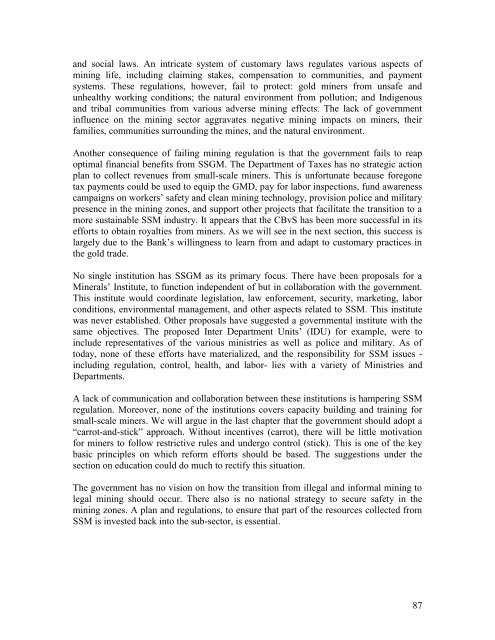SITUATION ANALYSIS OF THE SMALL-SCALE GOLD ... - WWF
SITUATION ANALYSIS OF THE SMALL-SCALE GOLD ... - WWF
SITUATION ANALYSIS OF THE SMALL-SCALE GOLD ... - WWF
You also want an ePaper? Increase the reach of your titles
YUMPU automatically turns print PDFs into web optimized ePapers that Google loves.
and social laws. An intricate system of customary laws regulates various aspects of<br />
mining life, including claiming stakes, compensation to communities, and payment<br />
systems. These regulations, however, fail to protect: gold miners from unsafe and<br />
unhealthy working conditions; the natural environment from pollution; and Indigenous<br />
and tribal communities from various adverse mining effects. The lack of government<br />
influence on the mining sector aggravates negative mining impacts on miners, their<br />
families, communities surrounding the mines, and the natural environment.<br />
Another consequence of failing mining regulation is that the government fails to reap<br />
optimal financial benefits from SSGM. The Department of Taxes has no strategic action<br />
plan to collect revenues from small-scale miners. This is unfortunate because foregone<br />
tax payments could be used to equip the GMD, pay for labor inspections, fund awareness<br />
campaigns on workers‟ safety and clean mining technology, provision police and military<br />
presence in the mining zones, and support other projects that facilitate the transition to a<br />
more sustainable SSM industry. It appears that the CBvS has been more successful in its<br />
efforts to obtain royalties from miners. As we will see in the next section, this success is<br />
largely due to the Bank‟s willingness to learn from and adapt to customary practices in<br />
the gold trade.<br />
No single institution has SSGM as its primary focus. There have been proposals for a<br />
Minerals‟ Institute, to function independent of but in collaboration with the government.<br />
This institute would coordinate legislation, law enforcement, security, marketing, labor<br />
conditions, environmental management, and other aspects related to SSM. This institute<br />
was never established. Other proposals have suggested a governmental institute with the<br />
same objectives. The proposed Inter Department Units‟ (IDU) for example, were to<br />
include representatives of the various ministries as well as police and military. As of<br />
today, none of these efforts have materialized, and the responsibility for SSM issues -<br />
including regulation, control, health, and labor- lies with a variety of Ministries and<br />
Departments.<br />
A lack of communication and collaboration between these institutions is hampering SSM<br />
regulation. Moreover, none of the institutions covers capacity building and training for<br />
small-scale miners. We will argue in the last chapter that the government should adopt a<br />
“carrot-and-stick” approach. Without incentives (carrot), there will be little motivation<br />
for miners to follow restrictive rules and undergo control (stick). This is one of the key<br />
basic principles on which reform efforts should be based. The suggestions under the<br />
section on education could do much to rectify this situation.<br />
The government has no vision on how the transition from illegal and informal mining to<br />
legal mining should occur. There also is no national strategy to secure safety in the<br />
mining zones. A plan and regulations, to ensure that part of the resources collected from<br />
SSM is invested back into the sub-sector, is essential.<br />
87
















